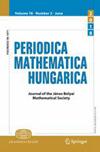On a class of Lebesgue-Ramanujan-Nagell equations
IF 0.5
3区 数学
Q3 MATHEMATICS
引用次数: 0
Abstract
We deeply investigate the Diophantine equation \(cx^2+d^{2m+1}=2y^n\) in integers \(x, y\ge 1, m\ge 0\) and \(n\ge 3\), where c and d are coprime positive integers satisfying \(cd\not \equiv 3 \pmod 4\). We first solve this equation for prime n under the condition \(\gcd (n, h(-cd))=1\), where \(h(-cd)\) denotes the class number of the imaginary quadratic field \({\mathbb {Q}}(\sqrt{-cd})\). We then completely solve this equation for both c and d primes under the assumption \(\gcd (n, h(-cd))=1\). We also completely solve this equation for \(c=1\) and \(d\equiv 1 \pmod 4\) under the condition \(\gcd (n, h(-d))=1\). For some fixed values of c and d, we derive some results concerning the solvability of this equation.
关于一类 Lebesgue-Ramanujan-Nagell 方程
我们深入研究了整数 \(x, y\ge 1, m\ge 0\) 和 \(n\ge 3\) 中的二叉方程 \(cx^2+d^{2m+1}=2y^n\) ,其中 c 和 d 是满足 \(cd\not \equiv 3 \pmod 4\) 的共正整数。我们首先在质数 n 的条件下求解这个方程(\(gcd (n, h(-cd))=1),其中\(h(-cd)\)表示虚二次域\({\mathbb {Q}}(\sqrt{-cd})\) 的类数。然后,我们在假设 \(\gcd (n, h(-cd))=1\) 的条件下对 c 和 d 素数完全求解这个方程。在(\gcd (n, h(-d))=1)的条件下,我们还可以完全求解这个方程的(c=1)和(d\equiv 1 \pmod 4\ )。对于 c 和 d 的一些固定值,我们得出了一些关于这个方程可解性的结果。
本文章由计算机程序翻译,如有差异,请以英文原文为准。
求助全文
约1分钟内获得全文
求助全文
来源期刊
CiteScore
1.40
自引率
0.00%
发文量
67
审稿时长
>12 weeks
期刊介绍:
Periodica Mathematica Hungarica is devoted to publishing research articles in all areas of pure and applied mathematics as well as theoretical computer science. To be published in the Periodica, a paper must be correct, new, and significant. Very strong submissions (upon the consent of the author) will be redirected to Acta Mathematica Hungarica.
Periodica Mathematica Hungarica is the journal of the Hungarian Mathematical Society (János Bolyai Mathematical Society). The main profile of the journal is in pure mathematics, being open to applied mathematical papers with significant mathematical content.

 求助内容:
求助内容: 应助结果提醒方式:
应助结果提醒方式:


